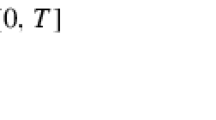Abstract
This paper studies the system stability problems of a class of nonconvex differential inclusions. At first, a basic stability result is obtained by virtue of locally Lipschitz continuous Lyapunov functions. Moreover, a generalized invariance principle and related attraction conditions are proposed and proved to overcome the technical difficulties due to the absence of convexity. In the technical analysis, a novel set-valued derivative is proposed to deal with nonsmooth systems and nonsmooth Lyapunov functions. Additionally, the obtained results are consistent with the existing ones in the case of convex differential inclusions with regular Lyapunov functions. Finally, illustrative examples are given to show the effectiveness of the methods.
Similar content being viewed by others
References
D. E. Stewart. Rigid-body dynamics with friction and impact. SIAM Review, 2000, 42(1): 3–39.
J. Cortes. Discontinuous dynamical systems: A tutorial on solutions, nonsmooth analysis, and stability. IEEE Control Systems Magazine, 2009, 28(3): 36–73.
G. Shi, Y. Hong. Global target aggregation and state agreement of nonlinear multi-agent systems with switching topologies. Automatica, 2009, 45(5): 1165–1175.
M. S. Branicky, V. S. Borkar, S. K. Mitter. A unified framework for hybrid control: model and optimal control theory. IEEE Transactions on Automatic Control, 1998, 43(1): 31–45.
D. Feijer, F. Paganini. Stability of primal-dual gradient dynamics and applications to network optimization. Automatica, 2010, 46(12): 1974–1981.
V. Utkin. Sliding Modes in Control Optimization. Berlin: Springer, 1992.
R. W. Brockett. Asymptotic stability and feedback stabilization. Differential Geometric Control Theory. R. W. Brockett, R. S. Millmann, H. J. Sussmann, eds. Boston: Birkhauser, 1983: 181–191.
P. Yi, Y. Hong, F. Liu. Distributed gradient algorithm for constrained optimization with application to load sharing in power systems. Systems & Control Letters, 2015, 83: 45–52.
J. P. Aubin, A. Cellina. Differential Inclusions. Berlin: Springer, 1984.
A. F. Filippov. Differential Equations with Discontinuous Righthand Sides. Boston: Kluwer Academic Publishers, 1988.
F. H. Clarke, Y. S. Ledyaev, E. D. Sontag, et al. Asymptotic controllability implies feedback stabilization. IEEE Transactions on Automatic Control, 1997, 42(10): 1394–1407.
K. E. Brenan, S. L. Campbell, L. R. Petzold. Numerical Solution of Initial-value Problems in Differential-algebraic Equations. New York: North-Holland, 1989.
J. S. Pang, J. Shen. Strongly regular differential variational systems. IEEE Transactions on Automatic Control, 2007, 52(2): 242–255.
A. Nagurney, D. Zhang. Projected Dynamical Systems and Variational Inequalities with Applications. New York: Springer, 1995.
B. Brogliato, A. Daniilidis, C. Lemaréchal, et al. On the equivalence between complementarity systems, projected systems and differential inclusions. Systems & Control Letters, 2006, 55(1): 45–51.
H. K. Khalil. Nonlinear Systems. 3rd ed. Upper Saddle River: Pearson Education, 2002.
L. Rifford. Existence of Lipschitz and semiconcave control–Lyapunov functions. SIAM Journal on Control & Optimization, 2000, 39(4): 1043–1064.
D. Shevitz, B. Paden. Lyapunov stability theory of nonsmooth systems. IEEE Transactions on Automatic Control, 1994, 39(9): 1910–1914.
A. Bacciotti, F. Ceragioli. Stability and stabilization of discontinuous systems and nonsmooth Lyapunov functions. Esaim Control Optimisation & Calculus of Variations, 1999, 4: 361–376.
E. Moulay, W. Perruquetti. Finite time stability of differential inclusions. IMA Journal of Mathematical Control & Information, 2005, 22(4): 465–475.
A. Bacciotti, L. Rosier. Lyapunov Functions and Stability in Control Theory. 2nd ed. Berlin: Springer, 2005.
F. H. Clarke, Y. S. Ledyaev, R. J. Stern, et al. Nonsmooth Analysis and Control Theory. New York: Springer, 1998.
R. G. Sanfelice, R. Goebel, A. R. Teel. Invariance principles for hybrid systems with connections to detectability and asymptotic stability. IEEE Transactions on Automatic Control, 2007, 52(12): 2282–2297.
N. Fischer, R. Kamalapurkar, W. E. Dixon. LaSalle-Yoshizawa corollaries for nonsmooth systems. IEEE Transactions on Automatic Control, 2013, 58(9): 2333–2338.
A. Bacciotti, F. Ceragioli. Nonpathological Lyapunov functions and discontinuous Carathéodory systems. Automatica, 2006, 42(3): 453–458.
S. P. Bhat, D. S. Bernstein. Nontangency-based Lyapunov tests for convergence and stability in systems having a continuum of equilibria. SIAM Journal on Control & Optimization, 2003, 42(5): 1745–1775.
Author information
Authors and Affiliations
Corresponding author
Additional information
This work was supported by the Beijing Natural Science Foundation (No. 4152057), the Natural Science Foundation of China (Nos. 61333001, 61573344), and the China Postdoctoral Science Foundation (No. 2015M581190).
Shu LIANG received the B.E. degree in Automatic Control and the Ph.D. degree in Engineering from the University of Science and Technology of China, Hefei, China, in 2010 and 2015, respectively. He is currently a postdoctoral fellow with the Academy of Mathematics and Systems Science, Chinese Academy of Sciences, Beijing, China. His research interests include nonsmooth systems and control, distributed optimizations, game theory, and fractional order systems.
Xianlin ZENG received the B.S. and M.S. degrees in Control Science and Engineering from the Harbin Institute of Technology, Harbin, China, in 2009 and 2011, respectively, and the Ph.D. degree in Mechanical Engineering from the Texas Tech University. He is currently a postdoctoral in Key Laboratory of Systems and Control, Institute of Systems Science, Chinese Academy of Sciences, Beijing, China. His current research interests include distributed optimization and distributed control, hybrid control and synchronization of network systems.
Yiguang HONG received his B.S. and M.S. degrees from Department of Mechanics, Peking University, China, and Ph.D. degree from Chinese Academy of Sciences (CAS). He is currently a professor in Academy of Mathematics and Systems Science, CAS. His research interests include nonlinear dynamics and control, multi-agent systems, distributed optimization, and social networks.
Rights and permissions
About this article
Cite this article
Liang, S., Zeng, X. & Hong, Y. Lyapunov stability and generalized invariance principle for nonconvex differential inclusions. Control Theory Technol. 14, 140–150 (2016). https://doi.org/10.1007/s11768-016-6037-2
Received:
Revised:
Accepted:
Published:
Issue Date:
DOI: https://doi.org/10.1007/s11768-016-6037-2



